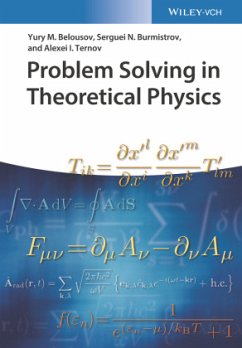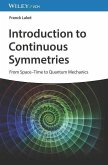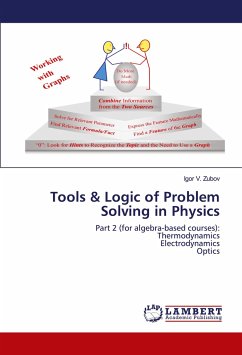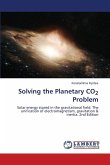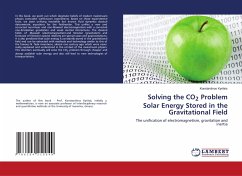- Broschiertes Buch
- Merkliste
- Auf die Merkliste
- Bewerten Bewerten
- Teilen
- Produkt teilen
- Produkterinnerung
- Produkterinnerung
"Problem Solving in Theoretical Physics" helps students mastering their theoretical physics courses by posing advanced problems and providing their solutions - along with discussions of their physical significance and possibilities for generalization and transfer to other fields.
Andere Kunden interessierten sich auch für
![Introduction to Continuous Symmetries Introduction to Continuous Symmetries]() Franck LaloeIntroduction to Continuous Symmetries70,99 €
Franck LaloeIntroduction to Continuous Symmetries70,99 €![Introductory Quantum Mechanics with MATLAB Introductory Quantum Mechanics with MATLAB]() James R. ChelikowskyIntroductory Quantum Mechanics with MATLAB59,99 €
James R. ChelikowskyIntroductory Quantum Mechanics with MATLAB59,99 €![Tools & Logic of Problem Solving in Physics Tools & Logic of Problem Solving in Physics]() Igor V. ZubovTools & Logic of Problem Solving in Physics32,99 €
Igor V. ZubovTools & Logic of Problem Solving in Physics32,99 €![Tools & Logic of Problem Solving in Physics Tools & Logic of Problem Solving in Physics]() Igor V. ZubovTools & Logic of Problem Solving in Physics37,99 €
Igor V. ZubovTools & Logic of Problem Solving in Physics37,99 €![Grundlagen kontinuierlicher Symmetrien Grundlagen kontinuierlicher Symmetrien]() Franck LaloeGrundlagen kontinuierlicher Symmetrien65,00 €
Franck LaloeGrundlagen kontinuierlicher Symmetrien65,00 €![Solving the Planetary CO2 Problem Solving the Planetary CO2 Problem]() Konstantinos KyritsisSolving the Planetary CO2 Problem28,99 €
Konstantinos KyritsisSolving the Planetary CO2 Problem28,99 €![Solving the CO2 Problem Solar Energy Stored in the Gravitational Field Solving the CO2 Problem Solar Energy Stored in the Gravitational Field]() Konstantinos KyritsisSolving the CO2 Problem Solar Energy Stored in the Gravitational Field20,99 €
Konstantinos KyritsisSolving the CO2 Problem Solar Energy Stored in the Gravitational Field20,99 €-
-
-
"Problem Solving in Theoretical Physics" helps students mastering their theoretical physics courses by posing advanced problems and providing their solutions - along with discussions of their physical significance and possibilities for generalization and transfer to other fields.
Hinweis: Dieser Artikel kann nur an eine deutsche Lieferadresse ausgeliefert werden.
Hinweis: Dieser Artikel kann nur an eine deutsche Lieferadresse ausgeliefert werden.
Produktdetails
- Produktdetails
- Verlag: Wiley-VCH
- Artikelnr. des Verlages: 1141396 000
- 1. Auflage
- Seitenzahl: 528
- Erscheinungstermin: 23. September 2020
- Englisch
- Abmessung: 23mm x 181mm x 244mm
- Gewicht: 1008g
- ISBN-13: 9783527413966
- ISBN-10: 3527413960
- Artikelnr.: 58597823
- Herstellerkennzeichnung Die Herstellerinformationen sind derzeit nicht verfügbar.
- Verlag: Wiley-VCH
- Artikelnr. des Verlages: 1141396 000
- 1. Auflage
- Seitenzahl: 528
- Erscheinungstermin: 23. September 2020
- Englisch
- Abmessung: 23mm x 181mm x 244mm
- Gewicht: 1008g
- ISBN-13: 9783527413966
- ISBN-10: 3527413960
- Artikelnr.: 58597823
- Herstellerkennzeichnung Die Herstellerinformationen sind derzeit nicht verfügbar.
BACKGROUND AND PROBLEMS
CHAPTER 1. THEORY OF FIELDS
Introduction
1.1 Vectors and tensors in the Euclidean space
1.2 Vectors and tensors in the Minkowski space
1.3 Relativistic kinematics
1.4 The Maxwell equations
1.5 Motion of a charged particle in the external field
1.6 Static electromagnetic field
1.7 Free electromagnetic field
1.8 The retarded potentials and radiation
1.9 Electromagnetic field of relativistic particles
1.10 The scattering of electromagnetic waves
CHAPTER 2. QUANTUM MECHANICS
Introduction
2.1 Operators and states in the quantum mechanics
2.2 One-dimensional motion
2.3 Linear harmonic oscillator
2.4 Angular momentum and spin
2.5 Motion in the magnetic field
2.6 Motion in the centrally symmetric field
2.7Semiclassical approximation
2.8 Perturbation theory
2.9 Relativistic quantum mechanics
2.10 Addition of angular momenta. The identity of particles
2.11 Theory of atoms and molecules
2.12 Theory of scattering
2.13 Theory of radiation
CHAPTER 3. STATISTICAL PHYSICS
Introduction
3.1 The Gibbs distribution. The thermodynamic quantities and functions
3.2 Quantum ideal gases
3.3 Non-ideal quantum systems (liquids)
3.4 Phase transitions and the critical phenomena
SOLUTIONS TO THE PROBLEMS
CHAPTER 4. THEORY OF FIELDS
4.1 Vectors and tensors in the Euclidean space
4.2 Vectors and tensors in the Minkowski space
4.3 Relativistic kinematics
4.4 The Maxwell equations
4.5 Motion of a charged particle in the external field
4.6 Static electromagnetic field
4.7 Free electromagnetic field
4.8 The retarded potentials and radiation
4.9 Electromagnetic field of relativistic particles
4.10 The scattering of electromagnetic waves
CHAPTER 5. QUANTUM MECHANICS
5.1 Operators and states in the quantum mechanics
5.2 One-dimensional motion
5.3 Linear harmonic oscillator
5.4 Angular momentum and spin
5.5 Motion in the magnetic field
5.6 Motion in the centrally symmetric field
5.7 Semiclassical approximation
5.8 Perturbation theory
5.9 Relativistic quantum mechanics
5.10 Addition of angular momenta. The identity of particles
5.11 Theory of atoms and molecules
5.12 Theory of scattering
5.13 Theory of radiation
CHAPTER 6. STATISTICAL PHYSICS
6.1 The Gibbs distribution. The thermodynamic quantities and functions
6.2 Quantum ideal gases
6.2.1 Ideal Fermi gas
6.2.2 Ideal Bose gas
6.2.3 Ideal gas of elementary Bose excitations
6.3 Non-ideal quantum systems (liquids)
6.3.1 Normal (nonsuperfluid) Fermi liquid
6.3.2 Superconductivity. The BCS theory
6.3.3 Weakly interacting Bose gas
6.3.4 Theory of superfluidity
6.4 Phase transitions and the critical phenomena
6.4.1 The mean-field approximation
6.4.2 The Ginzburg-Landau functional
6.4.3 The fundamentals of the theory of critical phenomena
APPENDICES
1 Dirac delta function and other distributions
2 Bessel functions of half-integer order
3 Confluent hypergeometric function. The Laguerre polynomials
4 Gamma function
CHAPTER 1. THEORY OF FIELDS
Introduction
1.1 Vectors and tensors in the Euclidean space
1.2 Vectors and tensors in the Minkowski space
1.3 Relativistic kinematics
1.4 The Maxwell equations
1.5 Motion of a charged particle in the external field
1.6 Static electromagnetic field
1.7 Free electromagnetic field
1.8 The retarded potentials and radiation
1.9 Electromagnetic field of relativistic particles
1.10 The scattering of electromagnetic waves
CHAPTER 2. QUANTUM MECHANICS
Introduction
2.1 Operators and states in the quantum mechanics
2.2 One-dimensional motion
2.3 Linear harmonic oscillator
2.4 Angular momentum and spin
2.5 Motion in the magnetic field
2.6 Motion in the centrally symmetric field
2.7Semiclassical approximation
2.8 Perturbation theory
2.9 Relativistic quantum mechanics
2.10 Addition of angular momenta. The identity of particles
2.11 Theory of atoms and molecules
2.12 Theory of scattering
2.13 Theory of radiation
CHAPTER 3. STATISTICAL PHYSICS
Introduction
3.1 The Gibbs distribution. The thermodynamic quantities and functions
3.2 Quantum ideal gases
3.3 Non-ideal quantum systems (liquids)
3.4 Phase transitions and the critical phenomena
SOLUTIONS TO THE PROBLEMS
CHAPTER 4. THEORY OF FIELDS
4.1 Vectors and tensors in the Euclidean space
4.2 Vectors and tensors in the Minkowski space
4.3 Relativistic kinematics
4.4 The Maxwell equations
4.5 Motion of a charged particle in the external field
4.6 Static electromagnetic field
4.7 Free electromagnetic field
4.8 The retarded potentials and radiation
4.9 Electromagnetic field of relativistic particles
4.10 The scattering of electromagnetic waves
CHAPTER 5. QUANTUM MECHANICS
5.1 Operators and states in the quantum mechanics
5.2 One-dimensional motion
5.3 Linear harmonic oscillator
5.4 Angular momentum and spin
5.5 Motion in the magnetic field
5.6 Motion in the centrally symmetric field
5.7 Semiclassical approximation
5.8 Perturbation theory
5.9 Relativistic quantum mechanics
5.10 Addition of angular momenta. The identity of particles
5.11 Theory of atoms and molecules
5.12 Theory of scattering
5.13 Theory of radiation
CHAPTER 6. STATISTICAL PHYSICS
6.1 The Gibbs distribution. The thermodynamic quantities and functions
6.2 Quantum ideal gases
6.2.1 Ideal Fermi gas
6.2.2 Ideal Bose gas
6.2.3 Ideal gas of elementary Bose excitations
6.3 Non-ideal quantum systems (liquids)
6.3.1 Normal (nonsuperfluid) Fermi liquid
6.3.2 Superconductivity. The BCS theory
6.3.3 Weakly interacting Bose gas
6.3.4 Theory of superfluidity
6.4 Phase transitions and the critical phenomena
6.4.1 The mean-field approximation
6.4.2 The Ginzburg-Landau functional
6.4.3 The fundamentals of the theory of critical phenomena
APPENDICES
1 Dirac delta function and other distributions
2 Bessel functions of half-integer order
3 Confluent hypergeometric function. The Laguerre polynomials
4 Gamma function
BACKGROUND AND PROBLEMS
CHAPTER 1. THEORY OF FIELDS
Introduction
1.1 Vectors and tensors in the Euclidean space
1.2 Vectors and tensors in the Minkowski space
1.3 Relativistic kinematics
1.4 The Maxwell equations
1.5 Motion of a charged particle in the external field
1.6 Static electromagnetic field
1.7 Free electromagnetic field
1.8 The retarded potentials and radiation
1.9 Electromagnetic field of relativistic particles
1.10 The scattering of electromagnetic waves
CHAPTER 2. QUANTUM MECHANICS
Introduction
2.1 Operators and states in the quantum mechanics
2.2 One-dimensional motion
2.3 Linear harmonic oscillator
2.4 Angular momentum and spin
2.5 Motion in the magnetic field
2.6 Motion in the centrally symmetric field
2.7Semiclassical approximation
2.8 Perturbation theory
2.9 Relativistic quantum mechanics
2.10 Addition of angular momenta. The identity of particles
2.11 Theory of atoms and molecules
2.12 Theory of scattering
2.13 Theory of radiation
CHAPTER 3. STATISTICAL PHYSICS
Introduction
3.1 The Gibbs distribution. The thermodynamic quantities and functions
3.2 Quantum ideal gases
3.3 Non-ideal quantum systems (liquids)
3.4 Phase transitions and the critical phenomena
SOLUTIONS TO THE PROBLEMS
CHAPTER 4. THEORY OF FIELDS
4.1 Vectors and tensors in the Euclidean space
4.2 Vectors and tensors in the Minkowski space
4.3 Relativistic kinematics
4.4 The Maxwell equations
4.5 Motion of a charged particle in the external field
4.6 Static electromagnetic field
4.7 Free electromagnetic field
4.8 The retarded potentials and radiation
4.9 Electromagnetic field of relativistic particles
4.10 The scattering of electromagnetic waves
CHAPTER 5. QUANTUM MECHANICS
5.1 Operators and states in the quantum mechanics
5.2 One-dimensional motion
5.3 Linear harmonic oscillator
5.4 Angular momentum and spin
5.5 Motion in the magnetic field
5.6 Motion in the centrally symmetric field
5.7 Semiclassical approximation
5.8 Perturbation theory
5.9 Relativistic quantum mechanics
5.10 Addition of angular momenta. The identity of particles
5.11 Theory of atoms and molecules
5.12 Theory of scattering
5.13 Theory of radiation
CHAPTER 6. STATISTICAL PHYSICS
6.1 The Gibbs distribution. The thermodynamic quantities and functions
6.2 Quantum ideal gases
6.2.1 Ideal Fermi gas
6.2.2 Ideal Bose gas
6.2.3 Ideal gas of elementary Bose excitations
6.3 Non-ideal quantum systems (liquids)
6.3.1 Normal (nonsuperfluid) Fermi liquid
6.3.2 Superconductivity. The BCS theory
6.3.3 Weakly interacting Bose gas
6.3.4 Theory of superfluidity
6.4 Phase transitions and the critical phenomena
6.4.1 The mean-field approximation
6.4.2 The Ginzburg-Landau functional
6.4.3 The fundamentals of the theory of critical phenomena
APPENDICES
1 Dirac delta function and other distributions
2 Bessel functions of half-integer order
3 Confluent hypergeometric function. The Laguerre polynomials
4 Gamma function
CHAPTER 1. THEORY OF FIELDS
Introduction
1.1 Vectors and tensors in the Euclidean space
1.2 Vectors and tensors in the Minkowski space
1.3 Relativistic kinematics
1.4 The Maxwell equations
1.5 Motion of a charged particle in the external field
1.6 Static electromagnetic field
1.7 Free electromagnetic field
1.8 The retarded potentials and radiation
1.9 Electromagnetic field of relativistic particles
1.10 The scattering of electromagnetic waves
CHAPTER 2. QUANTUM MECHANICS
Introduction
2.1 Operators and states in the quantum mechanics
2.2 One-dimensional motion
2.3 Linear harmonic oscillator
2.4 Angular momentum and spin
2.5 Motion in the magnetic field
2.6 Motion in the centrally symmetric field
2.7Semiclassical approximation
2.8 Perturbation theory
2.9 Relativistic quantum mechanics
2.10 Addition of angular momenta. The identity of particles
2.11 Theory of atoms and molecules
2.12 Theory of scattering
2.13 Theory of radiation
CHAPTER 3. STATISTICAL PHYSICS
Introduction
3.1 The Gibbs distribution. The thermodynamic quantities and functions
3.2 Quantum ideal gases
3.3 Non-ideal quantum systems (liquids)
3.4 Phase transitions and the critical phenomena
SOLUTIONS TO THE PROBLEMS
CHAPTER 4. THEORY OF FIELDS
4.1 Vectors and tensors in the Euclidean space
4.2 Vectors and tensors in the Minkowski space
4.3 Relativistic kinematics
4.4 The Maxwell equations
4.5 Motion of a charged particle in the external field
4.6 Static electromagnetic field
4.7 Free electromagnetic field
4.8 The retarded potentials and radiation
4.9 Electromagnetic field of relativistic particles
4.10 The scattering of electromagnetic waves
CHAPTER 5. QUANTUM MECHANICS
5.1 Operators and states in the quantum mechanics
5.2 One-dimensional motion
5.3 Linear harmonic oscillator
5.4 Angular momentum and spin
5.5 Motion in the magnetic field
5.6 Motion in the centrally symmetric field
5.7 Semiclassical approximation
5.8 Perturbation theory
5.9 Relativistic quantum mechanics
5.10 Addition of angular momenta. The identity of particles
5.11 Theory of atoms and molecules
5.12 Theory of scattering
5.13 Theory of radiation
CHAPTER 6. STATISTICAL PHYSICS
6.1 The Gibbs distribution. The thermodynamic quantities and functions
6.2 Quantum ideal gases
6.2.1 Ideal Fermi gas
6.2.2 Ideal Bose gas
6.2.3 Ideal gas of elementary Bose excitations
6.3 Non-ideal quantum systems (liquids)
6.3.1 Normal (nonsuperfluid) Fermi liquid
6.3.2 Superconductivity. The BCS theory
6.3.3 Weakly interacting Bose gas
6.3.4 Theory of superfluidity
6.4 Phase transitions and the critical phenomena
6.4.1 The mean-field approximation
6.4.2 The Ginzburg-Landau functional
6.4.3 The fundamentals of the theory of critical phenomena
APPENDICES
1 Dirac delta function and other distributions
2 Bessel functions of half-integer order
3 Confluent hypergeometric function. The Laguerre polynomials
4 Gamma function

